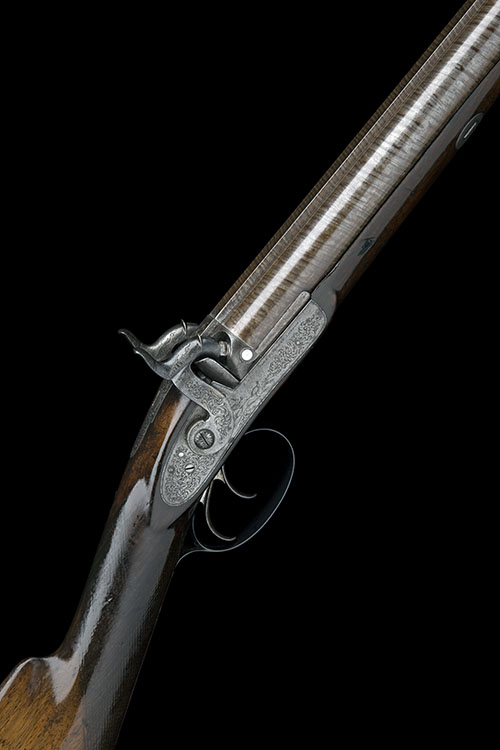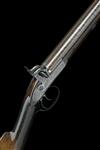Product Details
JOHN BLISSETT, LONDON
A GOOD CASED 14-BORE PERCUSSION DOUBLE-BARRELLED SPORTING-GUN, serial no. 1936,
circa 1845, with browned twist-iron 30 in. barrels, the raised concave top-rib with traces only of address, engraved breech-block with platinum plugs, fully engraved top-tang, borderline and scroll engraved locks also featuring depictions of gamebirds and signed 'JOHN BLISSETT, LONDON', engraved slab-sided dolphin headed hammers, walnut half-stock chequered at the wrist (worn), the right hand side with oval applied nickel plaque inscribed 'EVAN J.W. MURRAY MACGREGOR, CAPTAIN IN WALMODEN'S (sic) CUIRASSIERS, AUSTRIAN SERVICE, DIED AT PESTH 28TH JUNE 1850', iron furniture and brass mounted mahogany ramrod, complete with its manufacturer's brass cornered walnut case, compartmented and lined in blue baize, parchment 'BLISSETT' label inside lid and containing a fine condition period powder-flask, a leather shot flask, take-down cleaning rod, wad punch and nipple key, the outer lid with flush-fitting circular handle
Other Notes: Wallmoden was the son of Johann Ludwig Reichsgraf von Wallmoden-Gimborn (1736–1811), an illegitimate son of George II. At the time of Ludwig's birth, Johann was British ambassador in Austria. Wallmoden first entered the Hanoverian army, and then in 1790 the Prussian Army. While serving in the Prussian army as a Captain in Wolfradt's Hussars he distinguished himself at the battle of Kaiserslautern winning the Pour le Mérite or 'Blue Max' but unfortunately also being bayoneted in the chest. After the Peace of Basel (5 April 1795), Wallmoden joined the Austrian army as Second Captain in Vecsey's Hussars, and on 1st January 1797 he was promoted to First Captain and joined the Karaczay-Chevaulegers. Later that year he was promoted to Major and joined the quartermaster service. On 7 June 1798 he was transferred to the Dragoon Regiment No. 2. and on 3rd August of the same year he was promoted to Lieutenant Colonel in Ulanenregimente No. 1 and to Colonel of the same regiment on 16 August 1800. In 1809 Wallmoden completed the negotiations in London as to the "Subsidienvertrag" between Austria and Great Britain. On his return to Vienna, he distinguished himself as a Brigadier-General at the Battle of Wagram. On 6 July, the second day of battle, Wallmoden was responsible for the left flank of the III Corps. He ordered an attack by the Liechtenstein Hussars who were on the enemy's right flank, which succeeded in disrupting the enemy and resulted in the capture of nine guns. During the withdrawal of the Austrian army to Moravia, the VI Corps formed the rearguard. Wallmoden led the Liechtenstein and Blankenstein Hussars in a successful delaying action at Hollabrunn on the 9th July and on several other occasions. During these rearguard actions he was lightly wounded and for his achievements at Wagram and in these later actions he was awarded the Knight's Cross of the Order of Maria Theresia and an army command from 13th July 1809.
After the Treaty of Vienna, Wallmode was promoted to Feldmarschallleutnant on 21 August 1809 and lived in Prague. In 1812 he was given permission by the Austrian Emperor to transfer first to the British Army, and then at the bequest of the British to the Imperial Russian Army, becoming overall commander of the Russian light troops under the commanders Dörnberg and Tettenborn and Chernichev, which became known as the Russian-German Legion, which he then merged into the Allied "army of the north". During the Battle of the Göhrde, he and his Corps held out against not only General Davout's force but also the French division under Pécheux, later penetrating into Schleswig and forcing the Danes to make peace. The Corps was disbanded upon the fall of Paris in 1814 and on 24 May 1815, Wallmoden rejoined the Austrian army, just in time for the Hundred Days War in which he led a column of the Austrian III Corps (Württemberg's) which fought the action at Seltz against the French General Rottembourg, after which his column combined with the other column of the III Corps and fought the Battle of La Suffel before besieging General Jean Rapp in Strasbourg. In August 1816 he was made Oberbefehlshaber (supreme commander) of the Austrian troops that were sent to the kingdom of Naples for the Neapolitan War. In 1821 he left the majority of the Austrian force in Naples and in June occupied Sicily, where he remained until 1823. When in 1827 Naples was completely evacuated by the Austrian troops, Wallmode became on 21 March 1827 Militärcommandant to Milan and he was made a secret counsel on 20 January 1831. On 18 September 1838, he was promoted to General of the Cavalry. On 1 March 1848, he was appointed deputy to Field Marshal Count Radetzky and on 19 October 1848 he was awarded the Grand Cross of the Austrian Order of Leopold on his retirement. After his retirement he lived in Vienna and, after falling and breaking his leg, he died there in his 94th year on 20 March 1862, leaving no descendants.
Pest was the chief town of Hungary, and second city to the Austro Hungarian empire
Please click HERE to view Terms & Conditions.
Estimate £1,500-2,500






